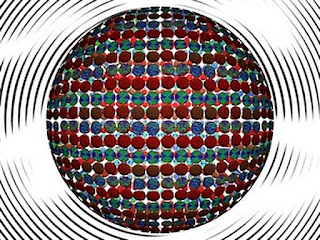MADISON – Liquid crystals, the state of matter that makes possible the flat screen technology now commonly used in televisions and computers, may have some new technological tricks in store.
Writing today (May 3, 2012) in the journal Nature, an international team of researchers led by University of Wisconsin-Madison Professor of Chemical and Biological Engineering Juan J. de Pablo reports the results of a computational study that shows liquid crystals, manipulated at the smallest scale, can unexpectedly induce the molecules they interact with to self-organize in ways that could lead to entirely new classes of materials with new properties.
"From an applied perspective, once we get to very small scales, it becomes incredibly difficult to pattern the structure of materials. But here we show it is possible to use liquid crystals to spontaneously create nanoscale morphologies we didn't know existed," says de Pablo of computer simulations that portray liquid crystals self-organizing at the molecular scale in ways that could lead to remarkable new materials with scores of technological applications.
In the absence of a liquid crystal, the molecules at the interface of the droplet adopt a homogeneous distribution. In the presence of a liquid crystal, however, they form an ordered nanostructure. "You have two things going on at the same time: confinement of the liquid crystals and an interplay of their structure with the interface of the droplet," notes de Pablo. "As you lower the temperature the liquid crystal starts to become organized and imprints that order into the surfactant itself, causing it to self assemble."
It was well known that interfaces influence the order or morphology of liquid crystals. The new study shows the opposite to be true as well.
"Now you can think of forming these ordered nanophases, controlling them through droplet size or surfactant concentration, and then decorating them to build up structures and create new classes of materials," says de Pablo.
As an example, de Pablo suggested that surfactants coupled to DNA molecules could be added to the surface of a liquid crystal droplets, which could then assemble through the hybridization of DNA. Such nanoscale engineering, he notes, could also form the basis for liquid crystal based detection of toxins, biological molecules, or viruses. A virus or protein binding to the droplet would change the way the surfactants and the liquid crystals within the droplet are organized, triggering an optical signal. Such a technology would have important uses in biosecurity, health care and biology research settings.
###
The new study was supported by the U.S. Department of Energy (DOE) through the Office of Basic Energy Sciences, and the U.S. National Science Foundation. In addition to de Pablo, authors of the new report include former postdoctoral fellows J.A. Moreno-Razo and E.J. Sambriski, now at the Autonomous Metropolitan University of Mexico and Delaware Valley College, respectively; Nicholas L. Abbott, of UW-Madison; and J.P. Hernández-Ortiz of the National University of Colombia.+sookie tex
Contact: Juan de Pablo depablo@engr.wisc.edu 608-262-7727 University of Wisconsin-Madison















No comments:
Post a Comment